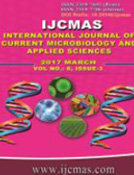


 National Academy of Agricultural Sciences (NAAS)
National Academy of Agricultural Sciences (NAAS)

|
PRINT ISSN : 2319-7692
Online ISSN : 2319-7706 Issues : 12 per year Publisher : Excellent Publishers Email : editorijcmas@gmail.com / submit@ijcmas.com Editor-in-chief: Dr.M.Prakash Index Copernicus ICV 2018: 95.39 NAAS RATING 2020: 5.38 |
In developing countries, prevalence of helminthiasis and anaemia has been one of the major public health problems where they cause micronutrient deficiencies of iron, folate, vitamin B12 and infectious diseases among children. Faecal samples and blood samples were obtained from 258 children. Faecal samples were examined using standard parasitological techniques, and anaemia was defined as blood haemoglobin <10 g/dL. Eighty five patients representing 47.2% were positive for hookworm, while 62 (34.4%) of the patients for Ascaris lumbricoides (A. lumbricoides). Trichuris trichiura (T. trichiura) was ranked third most positive with 25 (14%), followed by Schistosoma mansoni (S. mansoni) with only 8 (4.4%) testing positive. Eighty six patients representing 48% who tested positive for helminthes had Hb< 10g/dl and were considered anaemic, while 94 (52) also tested positive for helminthes but had Hb >10g/dl and were considered non anaemic. Sixteen of the patients representing 29% who tested negative for helminthes had Hb<10g/dl (anaemic) while 62(79%) patients who tested negative had Hb >10g/dl (non anaemic). Public enlightenment programmes should be carried out on personal and good hygiene at controlling of intestinal helminth infection and anaemia.
 |
 |
 |
 |
 |